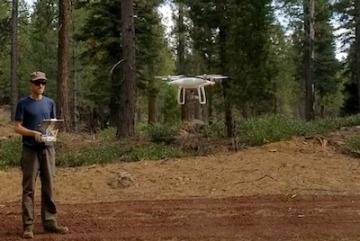Open Forest Observatory creates new tools for better forest management
CyVerse collaborates on Open Forest Observatory, a new open science resource for environmental managers that combines drone photography, forest mapping, machine learning, remote sensing, and big-data crunching.

Drone image by Derek Young, UC Davis, Dept. of Plant Sciences
Environmental managers will have a powerful new resource for helping our forests survive and recover from wildfire, drought and disease.
UC Davis ecologist Derek Young is leading a team to develop the Open Forest Observatory, a pioneering project combining drone photography and forest mapping with machine learning, remote sensing, big-data crunching and open information sourcing. The observatory will offer technology so friendly that users will need only a few weeks to learn it, instead of a year. And, for the first time, the project will make the resulting database available in a central repository. Tyson Swetnam, a co-lead and research assistant professor of geoinformatics with the University of Arizona, will spearhead data storage and processing through CyVerse, a platform for cloud-based computation and analysis for which he is also a co-PI. UC Boulder's Michael Koontz, another project co-lead, will head development of an open, reproducible workflow to create digital maps, plus training to use them, through the University of Colorado’s Institute for Research in Environmental Sciences.
“We'll be producing the data and the tools to help others address vexing forest ecology and land management questions,” explained Young, an assistant professional researcher with the Department of Plant Sciences.
A $1-million grant from the National Science Foundation is funding the observatory over five years. Open Forest Observatory takes off this month, offering the potential to lift ecological research to new heights.
New process, technology, availability
Thanks to high-definition cameras now available on drones at relatively low cost, the observatory will host a database of detailed, on-the-ground information, down to the sizes, species and health of individual trees.
Young’s team will develop software for creating these maps using best practices in drone-based forest imaging; as part of their previous work, they comprehensively codified those practices for the first time. Researchers and forest managers will be able to access the observatory’s maps to answer their own questions, or use its tools to produce new maps and share them through the observatory.
The result will be massive amounts of information, organized to allow all kinds of variables to be compared over space and time.

Young added that the project will also offer drone pilot training for UC Davis students, plus drone piloting and forest mapping concepts to high-school students in towns affected by wildfire.
Wrestling forest density
The observatory can help scientists wrestle urgent problems, such as how to thin dangerously dense forests despite insufficient budgets.
“Forest thinning in the densest stands in the driest locations will be an effective way to reduce tree mortality during extreme drought,” Young said.
In many areas, trees are growing up to 400 per acre, compared to 80 per acre in a healthy forest, according to the Sierra Nevada Conservancy. With 25 million forested acres in the Sierra Nevada, tree density raises wildfire risk and endangers watersheds up and down the range – and water supply for three-quarters of California residents.
“It’s one of the biggest challenges that natural resource managers are facing right now,” Young said.
The team’s grant also includes looking at how–and whether–new trees sprout in burned areas. They’ll start with maps created before a fire, then revisit the area to map surviving trees.
“To predict how seeds will disperse into these burned areas, you need to know where the surviving trees are, how they are arranged spatially, what species they are and how dense they are,” Young said. Burned areas could be tracked into the future to see how long survivors last and how quickly new vegetation establishes.
“Open Forest Observatory will help us respond to the environmental impacts of wildfires, insect outbreaks and plant diseases that are the real consequences of our forest trees already being stressed by heat and drought,” added CyVerse's Swetnam.

